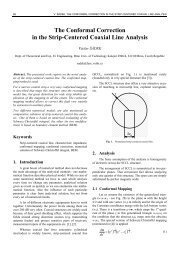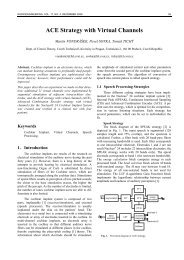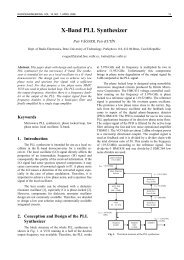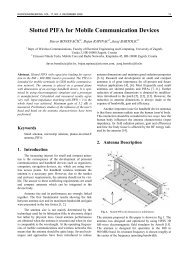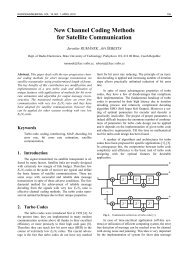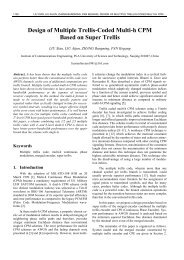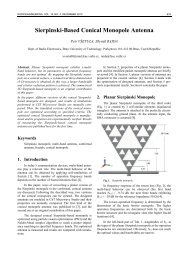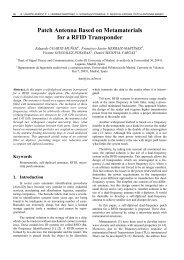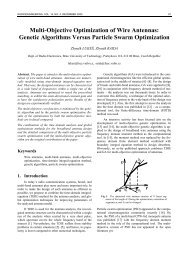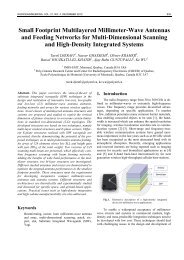full-text - Radioengineering
full-text - Radioengineering
full-text - Radioengineering
You also want an ePaper? Increase the reach of your titles
YUMPU automatically turns print PDFs into web optimized ePapers that Google loves.
180 S. SURAV YILMAZ, A. T. TOLA, R. ARSLANALP, A NOVEL SECOND-ORDER ALL-PASS FILTER USING SQUARE-ROOT …<br />
Current Mode<br />
Voltage Mode<br />
Properties [12] [13] [20] [11] [14] [16] [17] [18] [21] Proposed<br />
Filter order First Second First Second Second First First First First Second<br />
High quality factor No* Yes No* Yes No No* No* No* No* Yes<br />
Electronically tunable Yes Yes Yes No No No Yes Yes Yes Yes<br />
High input impedance _ _ _ No Yes Yes Yes Yes No Yes<br />
Grounded capacitors No Yes Yes No Yes Yes Yes Yes No Yes<br />
Resistorless design Yes Yes Yes No No No Yes Yes Yes Yes<br />
Number of canonical capacitors Yes No Yes Yes Yes Yes Yes Yes Yes Yes<br />
Supply voltage (V) ±2.5 3 ±2.5 ±2.5 ±3 ±2.5 ±2.5 ±5 ±2.5 2.7<br />
Power dissipation (mW) NA** 25.3 NA** NA** 99.5 NA** NA** NA** 15.6 9.67<br />
Tab. 1. Comparison of the proposed filter with other first and second order all-pass filters.<br />
*If cascaded to obtain second order all-pass filter<br />
**Not available<br />
In this paper, second order all-pass SRD filter circuit<br />
is designed by using the state-space synthesis method. The<br />
proposed circuit has high quality factor, high input impedance,<br />
only two grounded capacitors and electronic tunable<br />
pole frequency. The proposed filter does not require critical<br />
passive element matching. The paper is organized as follows:<br />
In section 2, the design method and architecture of<br />
the proposed second order all-pass SRD filter circuit is<br />
explained. Performance of the designed filter circuit is<br />
presented in section 3 by using PSpice simulation program.<br />
Obtained time domain and frequency domain responses as<br />
well as THD, Monte-Carlo and noise analysis results are<br />
given in this section. Finally, some conclusions are given in<br />
the last section.<br />
2. Circuit Design<br />
In this paper, second order SRD all-pass filter is designed<br />
by using the state-space synthesis method. The<br />
state-space synthesis method is more generally powerful<br />
and efficient approach. It defines not only input and output<br />
variables but also internal state variables. This allows us to<br />
observe and control all internal variables. Therefore, we<br />
can obtain the status of internal variables simply by using<br />
dynamic state-space equations.<br />
A general second order all-pass filter’s transfer function<br />
is given in (1), where ω 0 is the pole frequency and Q is<br />
the quality factor of the filter.<br />
Vout<br />
y s <br />
/ Qs<br />
H(s)= <br />
V u s Qs<br />
in<br />
2 2<br />
0 0<br />
2 2<br />
0 / 0<br />
. (1)<br />
According to the state-space synthesis method, statespace<br />
equations can be obtained from the transfer function<br />
by using several methods [22], [23], [24]. In this study, we<br />
use the modified companion method [24], [25] for statespace<br />
representation of (1). State-space representation of<br />
the proposed all-pass filter obtained by using this technique<br />
is expressed as (2).<br />
0<br />
2 0<br />
2<br />
y<br />
y<br />
0<br />
y u<br />
u<br />
0u<br />
,<br />
Q<br />
Q<br />
x1 y r1<br />
u,<br />
(2)<br />
x<br />
r u<br />
0x2<br />
1 2<br />
where u is input, y is output, x 1 and x 2 are the state variables,<br />
r 1 and r 2 are coefficients depending on the pole frequency<br />
and quality factor and these coefficients are given<br />
in (3).<br />
r<br />
2<br />
0<br />
1<br />
1;<br />
r2<br />
. (3)<br />
Then some adjustments are applied to (2) and the<br />
state-space representation of the system is obtained as (4).<br />
20<br />
<br />
0 0<br />
<br />
x<br />
1 x <br />
1 Q<br />
<br />
<br />
<br />
<br />
0<br />
u<br />
x<br />
<br />
<br />
<br />
2 0 x<br />
<br />
<br />
<br />
<br />
2<br />
20<br />
<br />
Q<br />
<br />
<br />
2 (4)<br />
Q <br />
x1<br />
1<br />
<br />
y 1 0 <br />
u<br />
x<br />
<br />
2<br />
0<br />
<br />
<br />
In this work, second order SRD all-pass filter is designed<br />
by using only current mode square-root blocks,<br />
current mirrors and two grounded capacitors. Therefore,<br />
the circuit equations must be formed only square-rooting<br />
terms. In order to design this filter in SRD, DC input u 2 is<br />
added to the system. For this purpose state-space equations<br />
are organized as follows (5).<br />
20<br />
<br />
0 0<br />
<br />
x<br />
1 x <br />
1 Q<br />
<br />
k1<br />
0<br />
<br />
<br />
<br />
0<br />
u u<br />
2<br />
x <br />
<br />
2 0 x <br />
<br />
<br />
<br />
2<br />
20 k20<br />
Q<br />
<br />
<br />
2 <br />
(5)<br />
Q <br />
x1<br />
1<br />
<br />
y 1 0 <br />
u<br />
x<br />
<br />
2<br />
0<br />
<br />
<br />
Q



